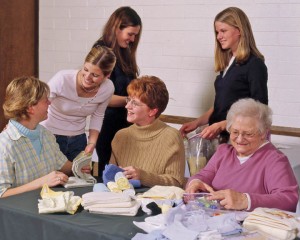In the early 1840s the Mormons were building a beautiful city in Nauvoo, and while most had what they needed, there were many who were poor and suffering. Most of the Saints gave freely of their substance to help those in need, but there was no organization, and sometimes the needs of others were not known.Some of the women began suggesting different ways to help, and as more women got involved, one of them, Sarah Kimball, said that the best way would be to form a ladies society to help the poor. On March 4, 1842, a group of local women in the neighborhood met in Sarah’s parlor and organized themselves. At the time, the state of Illinois required that benevolent societies have a constitution, bylaws, and elected officers. Eliza R. Snow, who later became a President of the Relief Society was asked to write both the constitution and bylaws. When she finished, she showed them to Joseph Smith the Prophet. When he saw them he said they were, “the best he had ever seen,” and that he also wanted to “provide something better for [the women of Nauvoo] than a written constitution. I will organize the women under the priesthood after the pattern of the priesthood” (Encyclopedia of Joseph Smith’s Teachings, Larry E. Dahl & Donald Q. Cannon eds., 1997).
The society was organized on March 17, 1842, with Emma Smith, Joseph’s wife, being elected as the first President. Numerous statements of zeal and desire to help those in need were given at the meeting, and the Prophet was touched. He stood up and said all his donations to the poor would be given to the society. He then donated a five dollar coin. Others followed his example and donated money to the Relief Society to aid the poor.
 The women worked tirelessly to find and help those in need. Widows and orphans were brought into others’ homes; time and service were given to many. As the Prophet watched the Relief Society work, he was again touched and stated, “it is natural for females to have feelings of charity. You are now placed in a situation where you can act according to those sympathies which God has planted in your bosoms. If you live up to your privileges the angels cannot be restrained from being your associates” (Parkin, Bonnie D., “Sweet Moments,” Conference Report, October 2005).With the promise of blessings for working to help the poor, the Relief Society pushed forward. A couple of the women suggested that each woman donate one cent per week to the Society to help buy glass and nails for the building of the Nauvoo Temple. Through this program a thousand dollars was raised for the temple.
The women worked tirelessly to find and help those in need. Widows and orphans were brought into others’ homes; time and service were given to many. As the Prophet watched the Relief Society work, he was again touched and stated, “it is natural for females to have feelings of charity. You are now placed in a situation where you can act according to those sympathies which God has planted in your bosoms. If you live up to your privileges the angels cannot be restrained from being your associates” (Parkin, Bonnie D., “Sweet Moments,” Conference Report, October 2005).With the promise of blessings for working to help the poor, the Relief Society pushed forward. A couple of the women suggested that each woman donate one cent per week to the Society to help buy glass and nails for the building of the Nauvoo Temple. Through this program a thousand dollars was raised for the temple.
The Relief Society also has another role, and that is to “save souls,” as the Prophet Joseph Smith stated. “The administration of charity under the direction of the Bishopric … was to be part of their active work. But this was not intended to absorb their activities to the exclusion of the development of faith, and the advancement of women in literary, social and domestic activities of life” (James R. Clark, comp., Messages of the First Presidency of The Church of Jesus Christ of Latter-day Saints, 1965-75, 5:217). In summary, the society was to be a place where women could teach one another, learn, and help improve the community.
The statement that the Relief Society is organized like the Priesthood also gives insight into the purpose of the Relief Society. “While the sisters have not been given the Priesthood . . . that does not mean that the Lord has not given unto them authority. Authority and Priesthood are two different things. A person may have authority given to him, or a sister to her, to do certain things in the Church that are binding and absolutely necessary for our salvation, such as the work that our sisters do in the House of the Lord”
(Dallin H. Oaks, “The Relief Society and the Church,” Ensign, May 1992, 34). Relief Society gives women the opportunity to help further the Church and its goals and to improve themselves and help those around them.
For More Information
Relief Society — MormonWiki.com